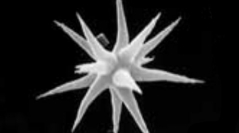

 Zoosystema
22 (2) - Pages 345-354
Zoosystema
22 (2) - Pages 345-354Four new species of the genus Tethya (Porifera, Demospongiae, Hadromerida) from different localities of the Pacific area are described. The new species are T. ornata n. sp. from Hawaii, T. simi n. sp. from Korea, T. strongylata n. sp. from the Galapagos and T. topsenti n. sp. from New Caledonia. T. ornata has a globose-ellipsoidal body with small conical tubercles. Spherasters, placed in the middle and inner cortical layers, are extremely variable in size and shape with truncated, forked, bent or rounded rays. Micrasters are tylasters, sometimes strongylasters, similar in the cortex and choanosome. T. simi has a globose body with flattened tubercles. Spherasters, placed in the whole cortex, have short, often apically bent or forked rays. Cortical micrasters are tylasters 8-12 µm, choanosomal micrasters oxyasters 15-20 µm in diameter. T. strongylata has a globose body with flattened tubercles. Strongyloxeas, often transformed in anisostrongyles, may be shortened in plump styles, anisostrongyles and styles. Spherasters, placed in the whole cortex, more densely in the inner layer and scatterly in the choanosome, have short rays often distorted, forked, spined or reduced to hemispherical outgrowths. Micrasters are tylasters, similar in the cortex and choanosome. T. topsenti has a body irregularly globose with indented tubercles and large cortical lacunes. Strongyloxeas, often transformed in anisostrongyles, run obliquely to the sponge surface. Spherasters, placed in the whole cortex and scatterly in the choanosome, are variable in size and shape and sometimes with flask-shaped rays. Micrasters are tylasters, similar in the cortex and choanosome with thick rays and swollen tylote tips.
Porifera, systematics, new species, Tethya, Pacific area.